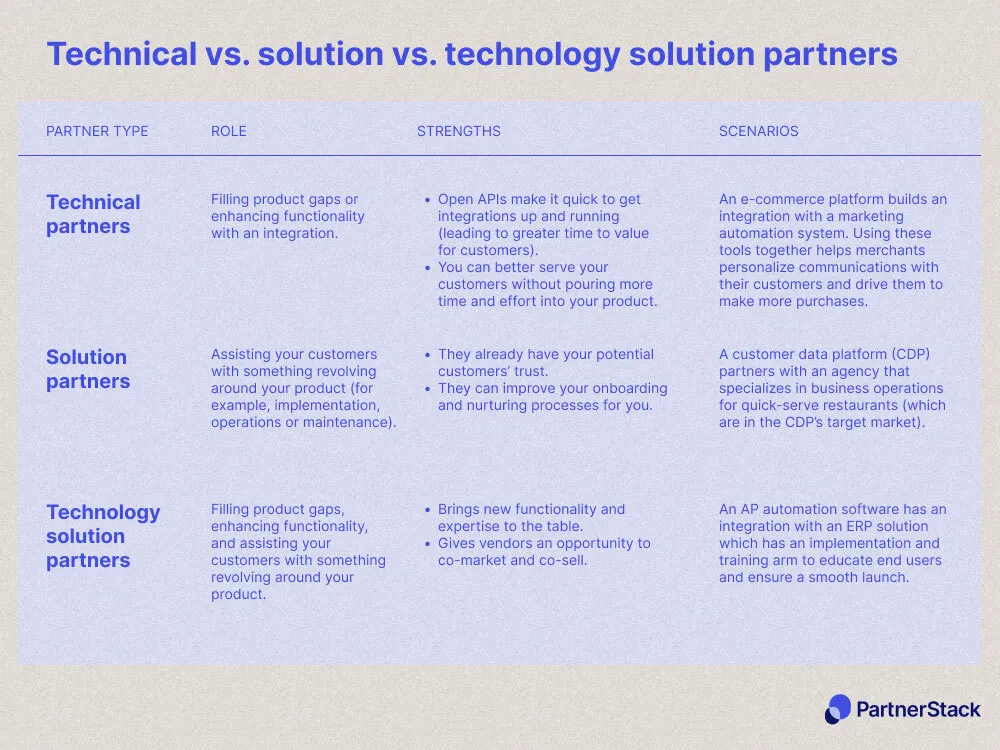There’s a lot of jargon in enterprise partnership management, and many terms mean different things in different orgs.
For new joiners to the partnership world, these distinctions can be confusing at best and set careers back at worst — going after the wrong partners screeches revenue to a halt.
So, with the help of Negar Nikaeein, Senior Channel Partner Manager at PartnerStack, we’re breaking down two of those common terms for you: technical and solution partners. And we’re even throwing in a third variant, technology solution partners.
Keep reading to learn how these partnerships typically play out in B2B SaaS, the advantages they bring to vendors and why choosing the right partners is so important to your program's success.
Understanding technical partners
In the SaaS world, technology partners, “tech partners” for short, are third-party apps or platforms that directly integrate with your product. The goal of the integration is to add more value to your customers and your partners’ customers.
Vendors pursue technology partnerships when they have:
- Product gaps: Sometimes, customers ask for a specific feature that your engineering team doesn’t have the time or resources to prioritize. Or it may be out of their range of expertise. Linking up with software that already does this gives your customers what they’re looking for while giving your product teams space to do what they do best.
- Good synergy with another company. There doesn’t always have to be something missing to warrant a technology partnership. Technical collaboration between enterprises can happen because the two tools are highly complementary.
Nikaeein explains, “At PartnerStack, we’re focused on centralizing data, automating partner operations and partner recruiting. While account mapping doesn’t fall naturally into the scope of our product, we know it's something that almost all of our customers do, so we integrate with account mapping tools like Crossbeam and Reveal.”
Why tech partnerships work
Patching the holes in your product roadmap and enhancing your product’s native functionality has four main benefits:
- Improved customer satisfaction: Great integrations streamline your customers’ workflow, giving them more time to spend on the activities that really matter.
- Improved customer retention: Integrations can also improve adoption and stickiness. And even if the customer eventually wants to go in a different direction, let’s face it — it’s much harder to rip and replace two (or more) tools than one.
- Customer expansion: Integrations with technology partners that have already established themselves in a new market help you go after a new vertical or geo much more efficiently.
- Increased revenue: Co-marketing with technical partners can boost your brand awareness and get you in front of potential customers you may not otherwise have access to.
Of course, you won’t get those results without being strategic. Choosing and prioritizing the right technical partners is key for small and large businesses alike. Without tech partner alignment and commitment, building the integration may take more time and effort for your engineering team — not less. And without customer demand, the integration will fall flat.
Nikaeein shares, “Your tech partner recruiting efforts must center on revenue impact. Tech partners should increase your revenue position somehow, whether by giving you an ‘in’ to a new market, making your product more competitive or sending you net new business.”
Related: Recruit your first 100 revenue-generating partners.
Exploring solution partners
The definition of solution partners is a bit more nebulous. At a high level, solution partners support your prospects and customers at some point in their lifecycle. These partners could be:
- Pre-sales advisors who help their clients source new tools to complete a project or improve the efficiency of a specific team.
- Agencies that offer implementation or advisory services. Or, they may also provide a completely different but complementary service. For example, if your product is a keyword research tool, you may partner with one or more SEO agencies.
- Consulting firms that specialize in implementing your tool, reinventing a team’s process, or rebuilding a company’s tech stack.
Establishing relationships with companies like these extends your customer support network without expending your internal resources. You provide a great product; they implement it or tie it into some other strategic business solution that moves your customer forward.
See more: How to start an agency partnership the right way.

Where solution partners excel
Solution partners bring much of the value that tech partners do, with an added benefit — trust. Ideally, customers already trust your solution partners to help them maximize the ROI of your tool, which gives you a leg up in sales conversations and gives you peace of mind, knowing that your software will be configured and used correctly.
In many ways, that means there’s more on the line for solution partners. If they can’t see the value in your product, they won’t tarnish their reputation with clients to promote it.
Nikaeein expounds, “Not all solution partners will be these lead gen tools that will burst your pipeline and bring you revenue. You have to make sure they offer services your customers will truly use and appreciate.”
A good way to be sure you’re pursuing the right solution partners, she says, is to embed yourself in the customer journey. Start by asking yourself what your customers consistently need help with.
Where are they getting stuck? Where do they seek third-party support? Hear this from the customers themselves, look for potential solution partners that could be a fit — and only then choose how to go to market with them.
Another tip from Nikaeein: don’t just think about what’s in it for you. Entice potential solution partners with pipeline. For example, you might say, ‘Hey Partner X, five customers already told us they have difficulty with Y problem — and I think your services would really help.’ Bringing them deals first encourages them to reciprocate.
Technology solution partners: A distinct category
We’re going to throw a wrench in things — technology solution partners also exist. According to Nikaeein, whether a company qualifies as a technology solution partner comes down to whether the partner and vendor commercialize the integration.
“If you’ve got a distinct GTM motion, commission structure and metrics for hitting customer retention and satisfaction, I’d call that more of a technology solution partner.”
She continues, “I’d consider a company even more of a technology solution partner if they provide an additional service to end customers, like a tech stack audit or advisory services around use cases for your integration.”
You see technology solution partners more in the enterprise space because that kind of software isn’t always self-serve and the sales cycles are harder and longer.
Technical vs. solution vs. technology solution partners
We’ve already delved into each type of partnership in detail. But it can be hard to keep track of the differences in your head. That’s why we’ve put together this table, juxtaposing the three types of partnerships to help you visualize where and how they differ.

To make these definitions even less abstract, take a look at the partner section of your existing partners’ websites. Chances are, they’ll have a library of partners to explore and will have tagged each partner according to their type.
Reviewing the ones labeled as technology, solution, and technology solution partners will give you a better sense of what those companies do and the value they’re providing to your partner — heck, you may even want to reach out to them yourself.
And if you’re still stuck, check out some of our inspiring case studies to learn how our customers have leveraged technology, solution and technology solution partners to level up their revenue game.
FAQs
What’s the difference between a tech partner manager and a solutions partner manager?
As you might expect, tech partner managers manage relationships with technology partners and solutions partner managers manage relationships with solution partners.
Tech partner managers typically have basic technical knowledge with a higher understanding of APIs than the average employee. They work closely with the product and engineering team and are interested in extensibility — growing bridges between your brand and other brands.
Solution partner managers, on the other hand, have strong experience in commercializing partnerships, brainstorming creative go-to-market motions, and business development. They’re more interested in the revenue side of the business.
When do I start when pursuing tech or solution partners?
First, you have to ask yourself whether you have the appropriate resources to support each type of partner.
If you’re considering expanding your program to include tech partnerships:
- Do you already have an open API?
- Do you have the engineering resources available to help build and test APIs?
- How collaborative do you feel your product and engineering team will be?
If you’re considering expanding your program to include solution partnerships:
- How well do you understand your customers’ journey?
- Are there solution partners you already know your customers trust?
- Will you be able to offer them a steady pipeline of leads?
What other types of partners are there?
Affiliates, referral partners, resellers, and distributors are all other common partner types that B2B SaaS companies pursue.
To learn more about what these partnerships are and the pros and cons of each, check out: What kind of partner program is right for you?
What if we’re not ready for tech, solution, or tech solution partners?
Affiliate programs can be thought of as the lowest-hanging fruit. Affiliate programs are fairly easy to launch because affiliates already have a captive audience and a marketing motion that you can plug into. Generating traffic from affiliates grows your brand presence and gives you some proof points, making attracting and converting top tech and solution partners easier.

















